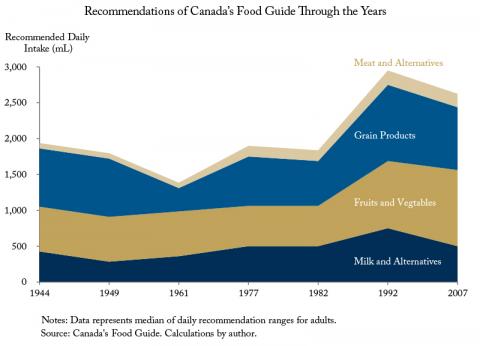From: Rosalie Wyonch
To: Minister of Health, The Hon. Jane Philpott
Date: November 17, 2016
Re: Canada’s Food Guide - Building on Shaky Foundations
The federal government recently announced plans to improve the outdated Canada Food Guide with the goal of curbing obesity and preventing health problems related to excess weight and an unhealthy diet. But more than a simple update is needed; it would be better to start from scratch, with an eye to reducing complexity and how much it tells you to eat in a day.
According to Health Canada, four out of five Canadians are at risk for developing heart disease, Type 2 diabetes and certain cancers; which studies have estimated cost Canadian society tens of billions in lost economic output each year. Though there are other factors that contribute to the development of these diseases, poor eating habits, physical inactivity, and excess weight are major contributors.
The Food Guide originated in 1942 within a framework of protecting agriculture markets by promoting domestic products in a time of scarcity and closed markets. The most significant difference between the most recent version and older versions is how much it tells you to eat in a day. The 2007 Guide tells Canadians to eat more (Figure 1). Given the variable nature of foods in each group and the significant variation in caloric and nutritional needs of individuals, the guide could potentially lead people to over-consume, even when following it. A recent Senate Report described the guide as “at best ineffective, and at worst enabling, with respect to the rising levels of unhealthy weights and diet-related chronic diseases in Canada.”
The Guide itself has expanded from one page in 1944 to six today. The 2007 version gives recommendations for different ages and genders with serving sizes for a variety of items listed in metric and imperial units, and a full four pages of example calculations and other information. These complicated recommendations are not practically useful to Canadians and are likely to be ignored, particularly among sub-groups of the population that face health disparities. Despite a high awareness of the Guide among consumers, less than half can correctly recall all four food groups and less than 1 percent of people could correctly identify how many servings they were supposed to have of each.
Given that the initial food rules were developed for different purposes and under different circumstances, attempting to force modern functions onto it is futile. It would be better to start from scratch, with an eye to simplicity.
Rosalie Wyonch is a Policy Analyst at the C.D. Howe Institute.
To send a comment or leave feedback, email us at blog@cdhowe.org.






